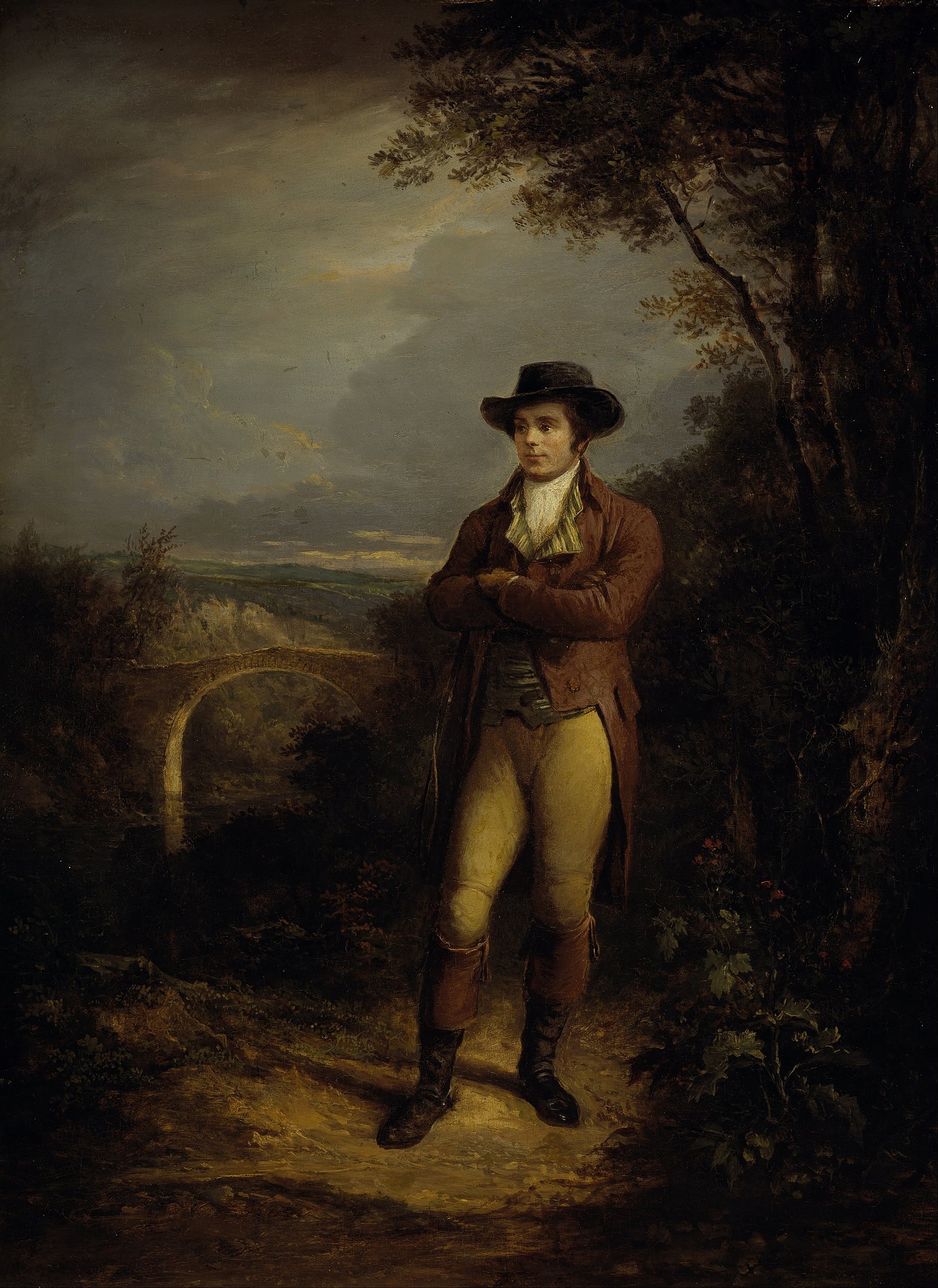Ewan Kennedy: Burns and the Gaelic

Alexander Nasmyth, Robert Burns (1828)
Ewan Kennedy explores the connections between our national bard and our other national language.
In Ayrshire, Gaelic had already largely died out before Burns was born in 1759. His Jacobite father had North East ancestry and didn’t have the language. While the Ayrshire Scots that Burns spoke incorporated a lot of Gaelic words and idioms, it’s likely that he wasn’t aware of their origins. True, his favourite sheepdog was called Luath, which is the Gaelic for fast, and “duan”, an ode, appears several times in poems, but few if any other Gaelic words appear. Of course he was familiar with many Gaelic tunes, famously the one that became Ae Fond Kiss.
This is no criticism of Burns – it’s just a fact that after the Jacobite period, feelings of mutual distinction and distrust between Lowland and Highland people were common and grew with distance, Ayrshire farmers being well distant.
Until he went to Edinburgh for the first time, in 1786 at the age of 27, Burns had no opportunity or wish to engage with actual Highlanders. But this really misses the point. His mission was solely to avoid having to work in the colonies by gaining wealthy sponsorship, in which he was entirely successful.
On his Highland trips the following year, which didn’t take him into the far west, or the islands, he stayed exclusively with English-speaking aristocrats he’d got introductions to, and wrote: “I write this on my tour through a country where savage streams tumble over savage mountains, thinly overspread with savage flocks, which starvingly support savage inhabitants.” There’s a clear sense of otherness here.
With the language closed to him, Burns’ exposure to Highland culture was largely through the works of James MacPherson. A native of Badenoch, he used his claim to have discovered the ancient poems of Ossian as a device to promote a romantic vision of Highlanders as almost a separate species. He was positioning himself as part of the generation of new Scots who saw their future abroad or down South, in his case working for some years in Florida and ending up the Member of Parliament for Camelford in Cornwall.
Everyone went wild about Ossian, Burns no exception, writing it was “a model for my conduct”. Translations into German, French and Danish appeared; Napoleon and Thomas Jefferson were both enthusiasts. They loved the image of a magic, wild Scotland, where fairies lived inside hills, water horses kidnapped small children, witches switched effortlessly into swans or hinds and back again. A major enthusiast was Johann Wolfgang von Goethe, who incorporated translations from Ossian into The Sorrows of Young Werther, published in 1774, when he was 24. There’s no evidence that Burns and Goethe ever met, but they had similar views, both Freemasons, and read each other’s work.
In the 1770s, Goethe was a major promoter of Sturm und Drang, the romantic culture that spread throughout Europe. A major feature of this was the troubles faced by young men, unable to persuade young women to love them. Burns’ own life and early death also fits the genre, apart from the young women.
Another poet who had a huge influence on Burns was Robert Fergusson. He died, aged 24, the year Werther came out, and could have fitted into Sturm und Drang perfectly. From his early teens Burns read his poems. He later wrote that when the muse had left him at one point it was reading Fergusson that got him going again. On his first visit to Edinburgh in 1786 Burns was shocked to find the grave was unmarked and commissioned a stone, which took him five years to pay for.
It contains the following verse:
Here lies Robert Fergusson, Poet
No sculptur’d marble here, nor pompous lay,
‘No story’d urn nor animated bust;’
This simple stone directs pale Scotia’s way
To pour her sorrows o’er her Poet’s dust.She mourns, sweet, tuneful youth, thy hapless fate,
Tho’ all the pow’rs of song thy fancy fir’d;
Yet Luxury and Wealth lay by in state,
And thankless starv’d what they so much admir’d.This humble tribute with a tear he gives,
A brother Bard, he can no more bestow;
But dear to fame thy Song immortal lives,
A nobler monument than Art can show.
Had he lived on, Fergusson would perhaps have approached Burns in reputation. Born in Edinburgh, he studied at St Andrews University, from where he was frequently at risk of expulsion for his extreme rudeness and his insistence on using the old Scots leid. When Dr Johnson visited Edinburgh he called him out as “Saint Sammy Sam, the lying loon”, provoked by the Doctor’s vitriol towards Ossian. He worked as a law clerk, while contributing several poems per month to two of the literary sheets that Edinburgh’s professional class devoured, the Weekly Magazine and the Edinburgh Amusement.
Fergusson eventually suffered a head injury when he was very drunk. His old mother cared for him until he had to be confined in the madhouse, where he died.
The two poets were similar in many ways. While Burns was a founder of the Tarbolton Club in Ayrshire, Fergusson was an early member of the Cape Club in the Old Town, both clubs that brought young men together in pubs for nights of drinking, declaiming, and devilment.
Deacon William Brodie was a member of the Cape. The name seems to have come from Cape Horn; rounding the cape meant avoiding the attention of the City Guard after curfew. At the end of Fergusson’s poem entitled “The Daft Days” we find:
And thou, great god of Aqua Vitae!
Wha sways the empire of this city,
When fou we’re sometimes capernity
Be thou prepar’d
To hedge us frae that black banditti
The City Guard
The City Guard were mainly former soldiers from the Highlands, pensioned off to keep the peace for six old pence a day. One can imagine a certain hostility on the part of these Gaelic speaking veterans towards a bunch of noisy, young, self confident professionals and part time poets. Unknown to them, among those tough old policemen was one of the greatest Gaelic poets of all time.
Donnchadh Bàn Mac an t-Saoir was a native of Glenorchy, who in his youth had worked as a gamekeeper for Sir John Campbell, the Earl of Breadalbane, known locally as the Old Rag. When the Duke of Argyll called up the lairds in 1745, Archibald Fletcher of Crannach didn’t want to go, and paid Duncan Bàn to go in his place for 300 merks. When, after the rout at Falkirk, he came back without Fletcher’s sword the laird refused to pay him. Eventually a barrage of poems and pressure from the Old Rag made Fletcher pay up.
Duncan Bàn composed the most remarkable poems, free style expressions of pure emotions, describing the scenery around places such as his beloved Beinn Dòrain, but often with an underlying political or polemical message. Others had to write them down, for he was illiterate.
While Duncan Bàn was policing the streets, his wife was running a pub in the Lawnmarket. This became a centre for lovers of her husband’s poems, which were published in several subscription editions from 1768. There’s no evidence that Fergusson and his pals knew of this alternative culture close by.
Did Burns know of Duncan Bàn? Probably not. He actually stayed with a later Earl of Breadalbane at Taymouth Castle during his Highland Tour, but there’s no indication that Duncan Bàn was mentioned, or even that this earl knew of him.
In fact hardly anyone outside the Gaeltacht had heard of Highland poets such as Duncan Bàn. None of Scotland’s anglophone literati, from MacPherson down to Sir Walter Scott, the architect of the tartan culture that took over Edinburgh at the time of the king’s visit, ever mentioned him.
It was well into the next century before Burns Suppers started to emerge, bedecked with tartan and Highland imagery. Then Burns’ poems started to be translated into Gaelic, suppressing further any awareness of the Gaelic bards.
None of what I’ve said detracts from Burns’ standing as a genius. On the contrary it places him in the centre of a firmly European culture. Tartanising him only diminishes him.
Postscript
Unlike Fergusson and Burns, both Duncan Bàn and his wife Màiri Bhàn òg (she was always young) survived into happy old age, untroubled by the Sturm und Drang. When well into his eighties, he was seen with Màiri Bhàn in Arisaig, “dressed in the Highland garb, with a checked bonnet over which a large bushy tail of a wild animal hung, a badger’s skin fastened by a belt in front, a hanger by his side, and a soldier’s wallet was strapped to his shoulders. … A forward young man asked him if it was he that made Beinn Dòrain? “No”, replied the venerable old man, “God made Beinn Dòrain, but I praised it.” He then inquired if I would buy a copy of his book? I told him to call upon me, paid him three shillings …”
(Having a book out myself, I rather hope that this won’t be me in my 80s!)







